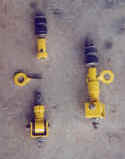
Swaybar Disconnects
More pictures below...
These are the sway bar disconnects that I came up with and a friend built for me. We deisgned these disconnects for my 1990 Toyota 4x4 truck, but the basic design could be applied to make disconnects for a variety of vehicles. (For example, you could have eye type mounts on both ends, or studs on both ends)
If you have an 86-95 IFS Toyota, you know by now that the sway bar on the front of these vehicles really limit the front suspension. There are several options to remedy this problem, including buying some pre made disconnects, building your own, or removing the sway bar all together. I ran these disconnects for almost a year until I decided to remove the sway bar completely. For my truck, driving without a sway bar offers no reduction in road handling. Below is a basic description of how to make some sway bar disconnects like the ones I had. If you are not up to that, you may want to look at purchasing a set from Drew Persson. In the end, you may end up like me with the sway bar just taking up space in the garage.
This is a revised copy of the original description I wrote and posted to the Toyota 4x4 mailing list. I have added few comments to bring the text up to date.
A friend of mine, Trevor Williams went ahead and made some sway bar disconnects before I could give him the drawings I made. No problem, we talked and the lengths matched perfect. I have several things to say about
these. First, these are very heavy duty. These things make some other mass produced
disconnects look wimpy as far as I am concerned. Another thing I like is the fact that he
made them so that if they broke (believe me, not very likely) parts can be removed and
replaced. I will try to describe them to the best I can. I did not give any length measurements here because it may vary from truck to truck depending on lift height and other factors. If you have any more questions, or if you use any of this to build a set for yourself, let me know. |
| This page last modified 07/10/03 |
Questions? Concerns? email DRM |